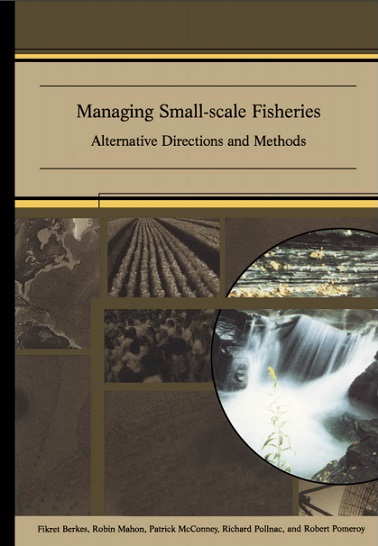Yazarlar: Fikret Berkes, Robin Mahon, Patrick McConney, Richard Pollnac, Robert Pomeroy
International Development Research Centre Yayını
308 Sayfa
ISBN: 0-88936-943-7
2021
(görsel ve bilgi: idl-bnc-idrc.dspacedirect.org)

Yazarlar: Fikret Berkes, Robin Mahon, Patrick McConney, Richard Pollnac, Robert Pomeroy
International Development Research Centre Yayını
308 Sayfa
ISBN: 0-88936-943-7
2021
(görsel ve bilgi: idl-bnc-idrc.dspacedirect.org)
Human dependence on marine and coastal resources is increasing. Today, small-scale fisheries employ 50 of the world’s 51 million fishers, practically all of whom are from developing countries. And together, they produce more than half of the world’s annual marine fish catch of 98 million tonnes, supplying most of the fish consumed in the developing world.
At the same time, increased fishery overexploitation and habitat degradation are threatening the Earth’s coastal and marine resources. Most small-scale fisheries have not been well managed, if they have been managed at all. Existing approaches have failed to constrain fishing capacity or to manage conflict. They have not kept pace with technology or with the driving forces of economics, population growth, demand for food, and poverty. Worldwide, the management and governance of small-scale fisheries is in urgent need of reform
One of the reasons for this neglect is that fisheiy science has largely been devoted to stock assessment, with a geographical focus on countries of the North and a disciplinary focus on biology and, to some extent, economics. As would be expected, such research has not served the fishery-management needs of the South, including countries that primarily depend on small stocks. Also, it has addressed neither the socioeconomic needs of fishing populations nor the potential benefits of more collaborative forms of governance.
In response, Canada‘s “International Development Research Centre” (IDRC) has funded research on the theory and practice of small-scale fisheries management in the developing world. Practically as one, this research has shown that to improve the state of fisheries (and, indeed, of most natural resources), managers need to exert more control over access. It has pioneered an interdisciplinary natural and social science of fishery management for the South, including approaches that are driven by management objectives, versions of local framework analysis, and survey methodologies in the mould of participatory rural appraisal. Recommendations have included new governance regimes, such as community-based management or comanagement, and increased use of local fishery knowledge.
This book presents alternative concepts, tools, methods, and conservation strategies, many of which were developed with IDRC support. It shows how to use these methods in a practical way and places a strong emphasis on ecosystem management and participatory decision-making. Natural resource managers, particularly of fisheries and aquatic resources, in developing countries, will find this book very useful, as will managers in other sectors because of the increasing spillover of management approaches across resource sectors. This book will also be of use to representatives
from all government agencies, development institutions, nongovernmental organizations,
international executing agencies, and donor agencies that are involved in fisheries management, particularly for the small-scale sector.
IDRC‘s hope is that this book will, in its own way, assist developing-country fisherfolk in their pursuit of a sustainable livelihood. We also hope that it presents a convincing case for a more people-centred model of natural resource management.
Brian Davy – Team Leader, Biodiversity
International Development Research Centre
İçindekiler:
-FOREWORD – Brian Davy vii
-PREFACE ix
CHAPTER 1: INTRODUCTION 1
1.1 Not just another fisheries book 1
1.2 A personal perspective 1
1.3 Scope of the book 5
1.4 Types of fisheries 6
1.5 Review of fisheries management from a “people” perspective 11
1.6 What comes next 17
CHAPTER 2: KEY CONCEPTS IN FISHERIES MANAGEMENT 19
2.1 Introduction 19
2.2 Ecosystem-based fishery management 20
2.3 Uncertainty and risk 23
2.4 Protected areas 25
2.5 Adaptive management 26
2.6 Management in information-deficient situations 28
2.7 Governance regimes 31
2.8 Stakeholder participation 33
2.9 Comanagement and empowerment 34
2.10 Conclusion 36
CHAPTER 3: FISHERY MANAGEMENT PLANNING AND OBJECTIVES 39
3.1 Introduction 39
3.2 An approach to management 39
3.3 Management planning process 42
3.4 The management plan – what should it include? 52
3.5 The fishery management unit 56
3.6 Fishery management objectives 58
3.7 Transparency: documentation, communication, and participation 66
3.8 Conclusion
74 CHAPTER 4: FISHERY INFORMATION 75
4.1 Introduction 75
4.2 Data and information collection 75
4.3 Traditional ecological knowledge 79
4.4 Literature acquisition and the Internet 85
4.5 Analysis and interpretation 91
4.6 Information management 92
4.7 Communication and use of information .94
4.8 Conclusions 99
CHAPTER 5: PROJECT ASSESSMENT AND EVALUATION
5.1 Introduction 101
5.2 The information stairway 102
5.3 Information categories 107
5.4 Preliminary assessment, baseline, monitoring, and evaluation methods 113
5.5 Conclusions 128
CHAPTER 6: FISHERY MANAGEMENT PROCESS 129
6.1 Introduction 129
6.2 Management process 129
6.3 Management measures 147
6.4 Enforcement and compliance 162
6.5 Conclusions 166
CHAPTER 7: MANAGING THE COMMONS 167
7.1 Introduction 167
7.2 “Tragedy of the commons” and its solutions 167
7.3 Who makes the rules to solve the commons dilemma? 173
7.4 Beyond regulation: managing fishing communities 182
7.5 Institutions and capacity building 186
7.6 Conclusions 191
CHAPTER 8: COMANAGEMENT AND COMMUNITY-BASED MANAGEMENT 193
8.1 Introduction 193
8.2 Conservation project of San Salvador Island, Philippines 193
8.3 Why comanagement? 196
8.4 What is fisheries comanagement? 201
8.5 Conditions affecting the success of fisheries comanagement 212
8.6 A process for community-centred fisheries comanagement 215
8.7 Conclusions 222
CHAPTER 9: NEW DIRECTIONS: A VISION FOR SMALL-SCALE FISHERIES 223
9.1 Small-scale fisheries in context 223
9.2 New directions: a vision for small-scale fisheries .226
9.3 New directions: concepts, methods, and tools 227
9.4 New directions: how you get there 228
APPENDIX 229
1.1 Questions for ultimate impact variables 229
1.2 Questions for intermediate impact variables 232
1.3 Questions for supra-community level context variables 234
1.4 Questions for community-level context variables 236
1.5 Questions for individual and household-level context variables 249
-GLOSSARY 255
-ABOUT THE AUTHORS 261
-REFERENCES 263
-INDEX 285
Bağlantı:
Yorumlar
İlk Yorumu Ekle